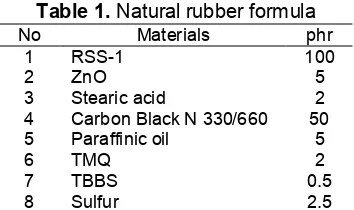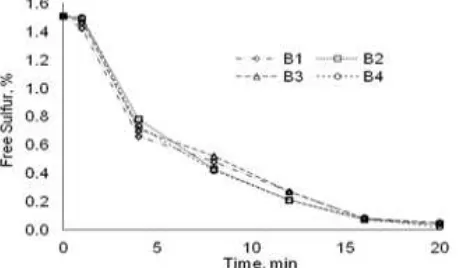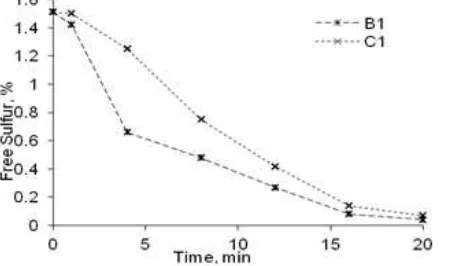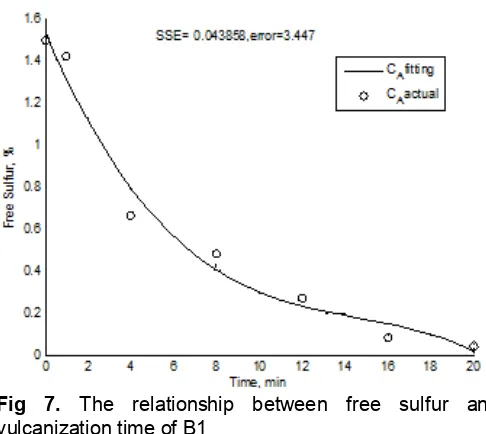Abu Hasan et al.
* Corresponding author. Tel/Fax : +62-711353414/711355918 Email address : abu_hasan@polsri.ac.id
VULCANIZATION KINETICS OF NATURAL RUBBER
BASED ON FREE SULFUR DETERMINATION
Abu Hasan1,2,*, Rochmadi2, Hary Sulistyo2, and Suharto Honggokusumo3 1
Department of Chemical Engineering, State Polytechnic of Sriwijaya, Jl. Srijaya Negara Bukit Besar, Palembang Indonesia 30139
2
Department of Chemical Engineering, Faculty of Engineering, Universitas Gadjah Mada, Jl. Grafika no. 2 Yogyakarta 55281
3
Gapkindo (The Indonesian Rubber Association), Jl. Cideng Barat no 62A Jakarta 10150
Received November 18, 2012; Accepted December 12, 2012
ABSTRACT
The determination of free sulfur in the rubber vulcanizates provided significant representation of vulcanization reaction. In this research, the effects of vulcanization temperature, the mixing method of carbon black into rubber, the ingredients mixing sequence and the type of carbon black were studied on masticated and milled natural rubber in which the reaction was observed by un-reacted sulfur determination. The results showed that higher vulcanization temperature provided faster vulcanization reaction and greater reaction rate constant. Similarly, the mixing sequence of ingredient and carbon black into rubber influenced the rate of vulcanization reaction. The subsequent ingredients mixing sequence, in this case, resulted in higher vulcanization rate compared to that of the simultaneous one. However, the mixing method of carbon black into rubber brought small effect on the rate of vulcanization reaction. The type of carbon black applied was observed to influence the reaction rate of vulcanization. Smaller particle sizes of carbon black gave larger reaction rate constant. In this case, the type of carbon black N 330 gave faster vulcanization rate than that of N 660.
Keywords: natural rubber; kinetics; sulfur; vulcanization
ABSTRAK
Penentuan belerang sisa atau free sulfur di dalam teknologi karet memberikan gambaran reaksi vulkanisasi karet. Di dalam penelitian ini, pengaruh-pengaruh suhu vulkanisasi, metode pencampuran carbon black ke dalam karet, urutan pencampuran bahan pengisi dan bahan kimia karet, dan penggunaan tipe carbon black dipelajari pada karet alam yang dimastikasi dan digiling dan diikuti dengan penentuan belerang sisa reaksi. Hasilnya menunjukkan bahwa semakin tinggi suhu vulkanisasi, semakin cepat reaksi vulkanisasi dan semakin besar konstanta kecepatan reaksi. Urutan pencampuran bahan kimia karet dan carbon black dalam karet memberikan pengaruh yang sama terhadap laju reaksi vulkanisasi, baik yang dilakukan secara bergiliran maupun secara simultan. Urutan secara bergiliran menghasilkan laju reaksi lebih cepat dibandingkan dengan yang dilakukan secara simultan. Metode pencampuran carbon black ke dalam karet memberikan pengaruh yang kecil pada laju reaksi vulkanisasi. Tipe carbon black yang digunakan mempengaruhi laju reaksi vulkanisasi. Semakin kecil ukuran partikel, semakin besar konstanta laju reaksi. Disini, carbon black tipe N 330 menghasilkan kecepatan reaksi vulkanisasi lebih cepat dari N 660.
Kata Kunci: karet alam; kinetika; belerang; vulkanisasi
INTRODUCTION
The reaction of rubber and sulfur changes physical and chemical properties of rubber. This is called as vulcanization reaction. Accelerator and activator form active accelerator complex. These active accelerator complex and rubber backbones have reacted to form active sulfurating agent and rubber bound intermediate,
then network formation with initial polysulfide crosslinks was followed by network maturation process. In the last stage, crosslink shortening with additional crosslinking, crosslink destruction with main chain modification (cyclic sulfide) and s-s bond interchange (pendent sulfidic group) are included [1].
Abu Hasan et al.
Table 1. Natural rubber formula
No Materials phr
Table 3. The mixing sequence of natural rubber of B and C
Table 2. The mixing sequence of natural rubber of A
No Materials Time, min
Table 4. The mixing sequence of natural rubber of D
No Materials Time, min
rubber backbone is formed [2]. Some methods to analyze the rubber vulcanization have been performed, such as, Bideau et al. [3] have used the short wave infra red irradiation, Jaunich et al. [4] monitored the reaction of vulcanization using ultrasonic online, Salgueiro et al. [5] used SANS, or Pazur et al. [6] used NMR. DSC was used to analyze the vulcanization reaction as conducted by Chough et al. [7], Manchado et al. [8], and Ding et al. [9]. Rheometer is one of the methods to analyze the vulcanization reaction and has been still very popular in rubber technology. In this method, the vulcanization reaction considered to be proportional to the change of the rubber stiffness. Cotten [10], Gerspacher et al. [11], Mahalling et al. [12], Choi [13], Choi et al. [14], and Wang et al. [15] have investigated the rubber vulcanization using rheometer. In order to obtain the rubber compound as raw material of rubber goods, the process of mastication and milling is required. Mastication and milling influence on physicals and chemicals properties of rubber vulcanizates. The sequence of rubber mixing, rubber chemicals, and filler of carbon black, on rubber mixing process analyzed by using rheometer, resulted in the change of physical properties [16-19]. Meanwhile, the determination of the reactant concentration during the reaction is still popular method to analyze the kinetics, but not yet in rubber technology. The application of this method is merely to determine the sulfur remain, also called free sulfur in vulcanized rubber. The reactant and reaction product are contradictive in which the small reactant will represent high reaction product. Besides the physical properties tests, solvent swell test, Mooney Rivlin equilibrium modulus, DSC, and spring constant; free sulfur determination are used to determine degree of curing in
vulcanized rubber [20]. In this research, free sulfur determination was used in the analysis of the vulcanization kinetics.
EXPERIMENTAL SECTION
Materials
The ribbed smoked sheet-1 (RSS-1) a kind of natural rubber produced in Indonesia and carbon black filler N 330 type from Cobot Indonesia are two main raw materials employed in this experiment. The rubber chemicals consisted of sulfur, tert butyl benzothiazole sulfenamide (TBBS), tetra methyl quinone (TMQ), zinc oxide (ZnO), stearic acid, and processing oil. In addition, free sulfur determination was carried out on vulcanized rubber. All materials and chemicals were the commercial grades without any treatment.
Instrumentation
The equipments used in this experiment are open two roll mill, hot press apparatus and glassware for free sulfur determination.
Procedure
Sample preparation of A
Abu Hasan et al.
Table 5. The addition of carbon black into natural rubber under the rubber mixing process
Code CB_1 CB_2+oil
1 10 phr 40 phr+oil
2 20 phr 30 phr+oil
3 30 phr 20 phr+oil
4 40 phr 10 phr+oil
Table 5 is coded as 1. Thus, this sample is then called A1. Rubber was initially masticated within 5 min, followed by additional ZnO and strearic acid that were milled within 2 min. TMQ was subsequently added into the mix and milled for 1 min. Carbon black in the amount of 10 phr was added into the mill and milled for 2 min then. Such process is called CB_1. In the process regarded as CB_2+oil, the remaining carbon black about 40 phr was added into the mix together with oil and then milled for 4 min. Then, the addition of TBBS and sulfur needed 1 min for milling time on each.
Sample preparation of B
Using the formula in Table 1, a mixing process was conducted in accordance with the sequence and the time each sequence needed as shown in Table 3. The sample produced in this process was then called B in which rubber was masticated for 1 min then followed by addition of strearic acid and milled for 1 min. Then sulfur and ZnO were added into the mill and milled for 2 min as well as carbon black in the amount of 10 phr that was added into the mill and milled for 3 min. Such process is called CB_1. In the process regarded as CB_2+oil, the remaining carbon black about 40 phr was added into the mill along with oil and milled for 7 min Following this, TBBS that was added into the mill was milled for 6 min and TMQ needed 1 min for milling time. The process of carbon black addition into the rubber was performed using a method applied to the sequence as shown in Table 5. The samples were, at last, designated as B1, B2, B3 and B4.
Sample preparation of C
By using a procedure similar to that of in B and using the sequence addition of carbon black into rubber as listed in Table 5 code 1-5, sample C1, C2, C3 and C4, which, in this case, used carbon black type N 660 as the filler, was able to be found.
Sample preparation of D
As listed in Table 4, a formula in Table 1 was applied for the mixing process as well - following the sequence and time allocated for each mixing. Rubber in this process was masticated for 3 min. Subsequently, of the total amount of 50 phr, 10 phr of carbon black was added and milled for 7 min. Such process needing 2 min for milling was called CB_1. In a process called as
CB_2+oil, the remains of 40 phr together with oil, in turn, was added into the rubber and required 5 min for milling. In sample called D1, ZnO and stearic acid were then added and milled for 2 min, followed by addition of TMQ, sulfur and TBBS milled for 1 minon each.
Sample preparation of vulcanized rubber and free sulfur determination
Rubber compound after milling and mixing process was vulcanized at the temperature of 150 °C - except on the samples A1 and D1. These vulcanizations were carried at the temperature of 140 °C, 150 °C, 160 °C, and 170 °C. Then, determination of free sulfur in the vulcanized rubber was based on ASTM D 297-93 method on the samples A1, B, C1 and D1. Here, all of the vulcanization times used to determine free sulfur were performed within 1, 4, 8, 12, 16 and 20 min - except on sample A1 that was vulcanized at 150 °C within 1, 3.5, 5, 8, 14, and 20 min. A sampling of free sulfur was conducted in heating rubber compound and pressed based on temperature and time. After the heating and pressing process and to prevent the reaction in vulcanization, the vulcanized rubber as the sample was immersed in cooling water at room temperature prior to keeping them in a cooling room before determining the free sulfur.
Reaction model
The reaction model used in this process was taken from the one proposed by Isayev and Sujan [21] and Ximei [22] as described in the following equations:
1
where A represents the total sulfur as vulcanizing agent or reactant, B as stable product such as cyclic sulfide and pendent sulfidic group, C as unstable product or polysulfide crosslinks, and D as end product or mono sulfide crosslinks. The kinetics equation was:
(
)
with initial conditions are as follows:
0
A A B C D
t = 0, C = C , C = 0, C = 0, and C = 0 (7)
Free sulfur (CA) in equation (3-5) as a function of
vulcanization time was interpolated referred to the original data. The result was then employed in the model equation and was able to find CB, CC, and CD as
Abu Hasan et al.
Fig 1. Sample of A1 under the influence of vulcanization temperature
Fig. 2 Sample of B under the influence of carbon black addition process into the rubber
Fig 3. The Influence of vulcanization time on the free sulfur of C1
method, difference between the original data and interpolation of free sulfur, at the SSE minimum, the values of k1, k2 and k3 in the equation (3-6) could be
determined.
RESULT AND DISCUSSION
Vulcanization Temperature
Fig. 1 shows the effect of vulcanization temperature on free sulfur of vulcanized rubber of A1. At this point, it is found that the higher the vulcanization temperature was, the faster the decrease of free sulfur would be. A same tendency as described in Fig. 1 is available in Fig. 4 for the sample of D1. Fig. 1 and Fig. 4 respectively show the difference of decreasing rate of free sulfur on vulcanized rubber upon vulcanization time samples of A1 and that of D1. Generally, the sample of D1 had a higher reaction rate than that of A1. Based on the sequence of rubber compounding process listed in Tables 2 and Table 4, both samples of A1 and sample of D1 were processed by distinguishing the carbon black addition and rubber chemicals into the rubber when the mixing process was run. Both carbon black and rubber
chemicals on sample of A1 were mixed and milled simultaneously, but in the sample of D1, carbon black was added before the addition of rubber chemicals. Besides that, the mastication time was distinguished as well in which the sample of A1 had mastication time of 5 min, meanwhile the sample of D1 had 3 min. The low mastication time or the high shearing force of rubber and the addition of carbon black before the addition of rubber chemicals into the rubber caused the breaking of carbon black aggregate into the number of small particles. Here, carbon black was dispersed into the rubber at ease. The smaller the particle sizes were, the higher the surface area of carbon black would be. This fact resulted in higher rubber molecules adsorbed on that surface. The simultaneous addition of carbon black and rubber chemicals could cause carbon black surface tainted by rubber chemicals. By so doing, carbon black is not functioning as catalyst [23].
The Mixing Method of Carbon Black into Rubber
Fig. 2 shows the effect of method of carbon black addition into rubber on free sulfur of the vulcanized rubber of B. From this figure, the method of carbon black addition into rubber did not influence the reaction rate significantly. Samples of B1, B2, B3 and B4 had the almost similar rate of reaction. The constant reaction rate as listed in Table 6 gives information that reaction rate did not distinguish significantly but still gave a bit picture.
The Reaction Rate of C1
Abu Hasan et al.
Table 6. Reaction rate constant of natural rubber vulcanization of samples of A1, B, C1 and D1.
Fitting Reaction Rate Constant, min-1 Codes
SSE k1 k2 k3
Temperature (°C)
- A11 0.000001 0.0281 0.0317 0.0205 140
- A12 0.02563 0.0645 0.0750 0.0376 150
- A13 0.03182 0.0898 0.1497 0.0428 160
- A14 0.01370 0.1306 0.1880 0.0325 170
- B1 0.04386 0.0643 0.1010 0.0689 150
- B2 0.02646 0.0586 0.0995 0.0508 150
- B3 0.04707 0.0653 0.0893 0.0464 150
- B4 0.03605 0.0822 0.0813 0.0427 150
- C1 0.00291 0.0416 0.0589 0.0340 150
- D11 0.003237 0.0334 0.0531 0.0350 140
- D12 0.002233 0.0744 0.1126 0.0649 150
- D13 0.000079 0.2772 0.4389 0.0356 160
- D14 0.000315 0.2768 0.4651 0.0591 170
Notes:
A11 and D11 were vulcanized by temperature at 140 °C, A12 and D12 150 °C, and A13 and D13 was at 160 °C and A14 and D14 170 °C. On the other hand, B1, B2, B3, B4 and C1, in turn, were vulcanized at temperature of 150 °C
Fig 4. The influence of vulcanization temperature of natural rubber to the vulcanization kinetics of D1
Fig 5. The influence of rubber mixing sequence on the vulcanization kinetics of natural rubber
Fig 6. The influence of carbon black type on the vulcanization kinetics of natural rubber
The Ingredients Mixing Sequence
Fig. 5 shows the decrease of free sulfur in the vulcanization time of the vulcanized rubber of A1, B1 and D1 with the variation of ingredients mixing sequences. From this figure, D1 had a higher reaction
rate compared to that of A1 and B1. In this case, both samples of A1 and B1 were simultaneously mixed by the addition of carbon black and rubber chemicals, while sample of D1 was subsequently mixed. The surface of carbon black on sample of D1 was not tainted by rubber chemicals [16-17] and carbon black was able to function as a better catalyst on vulcanization reaction [23]. The mastication time on sample of B1 was shorter than that of D1, but rubber chemicals tainted the surface of carbon black and shearing force became low, thus leading the breaking of carbon black aggregates to be low then. Here, carbon black is hard to be dispersed into the rubber and was not able to function as a catalyst as well. The mastication time on sample of A1 was higher than that of D1 and the surface of carbon black had been tainted by rubber chemicals. This then made the reaction rate lower than that of D1. Table 6 informs the reaction rate constant of A1, B1 and D1 where k1, k2, and k3 ofD1
Abu Hasan et al.
Fig 7. The relationship between free sulfur and vulcanization time of B1
Fig 8. Kinetics model of natural rubber vulcanization of B1
Carbon Black Type
Fig. 6 shows the decrease of free sulfur in the vulcanized rubber of B1 and C1. The reaction rate of B1 was higher than that of C1. On the other hand, k1, k2,
and k3 of B1 are also found to be higher than that of C1
as listed in Table 6. The distinction of the used carbon black type caused the distinction of a reaction rate. B1 used the carbon black type N 330 and C1 N 660 in which the particle size of carbon black type N 330 was smaller than that of N 660. The smaller the particle sizes of carbon black were, the easier the particle of carbon black dispersed into the rubber was. At this point, the carbon black could function as a catalyst [23].
Reaction Model
Fig. 7 depicts one of free sulfur interpolation in which its result was then substituted in the equation model as described in Fig. 8. This figure shows the change of A to B, and A to C and D with the reaction rate constant k1 = 0.0521, k2 = 0.1109 and k3 = 0.0722.
Others were able to be found with the similar procedure as found in k1, k2, and k3 on sample of B1. Table 6
shows k1, k2, and k3 of A1, B, C1 and D1. Here, A1
comprised A11, A12, A13 and A14. Meanwhile, B1, B2, B3 and B4 were included in B, and D1 that consisted of D11, D12, D13 and D14.
Table 6 provides the information about the effects of vulcanization temperature on the vulcanized rubber of A11 to A14 and D11 to D14, the effect of ingredients mixing sequence in rubber compounding of A12, B1, and D12, the mixing process method of carbon black into the rubber on vulcanized rubber of B1 to B4, and the use of carbon black type on the vulcanized rubber of B1 and C1
upon the reaction rate constants of vulcanized natural rubber (k).
By using an Arrhenius plotting for samples of A1 and D1, k then was resulted to be as a temperature function. The values of k1, k2, and k3 for samples of A1
and D1 were listed in Table 7. From this table, the reaction rate of D1 was higher than that of A1 for the increase of temperature. It means that the reaction rate of D1 is faster than that of A1.
CONCLUSION
Abu Hasan et al.
ACKNOWLEDGEMENT
I would like to express my gratitude to Directorate General of Higher Education, Republic of Indonesia (in the scheme of Doctor Dissertation Grant 2010) and Polymer Technology Laboratory of Chemical Engineering Department, Faculty of Engineering, Universitas Gadjah Mada as well as Bogor Research Station for Rubber Technology.
REFERENCES
1. Krejsa, M.R., and Koenig, J.L., 1993, Rubber Chem. Technol., 66. 3, 376–410.
2. Morton, M., 1987, Rubber Technology, 3rd ed., Van Nostrand Reinhold, New York.
3. Bideau, P.L., Ploteau, J-P., Dutournié, P., and Glouannec, P., 2000, Int. J. Therm. Sci., 48, 3, 573– 582.
4. Jaunich, M., Stark, W., and Hoster, H., 2009, Polym. Test., 28, 1, 84–88.
5. Salgueiro, W., Samoza, A., Torriani, I.L., and Marzocca, A.J., 2007, J. Polym. Sci., Part B: Polym. Phys., 45, 21, 2966–2971.
6. Pazur, R.J., Walker, F.J., and Plymout, M.I., 2011, Kautsch. Gummi Kunstst., 64, 1-2, 16, 18–23.
7. Chough, S-H., and Chang, D-H., 1996, J. Appl. Polym. Sci., 61, 3, 449–454.
8. López-Manchado, M.A., Arroyo, M., Herrero, J., and Biagiotti, J., 2003, J. Appl. Polym. Sci., 89, 1, 1–15. 9. Ding, R., and Leonov. A.I., 1996, J. Appl. Polym.
Sci., 61, 3, 455–463.
10. Cotten, G.R., 1972, Rubber Chem. Technol., 45, 1, 129–144.
11. Gerspacker, M., Niliel, L., Yang, H.Y., O’Farrel, C.P.,
and Schwartz, G.A., 2001, Flocculation in Carbon Black Filled Rubber Compounds
,
Meeting of the Rubber Division, American Chemical Society, Cleveland, Ohio,USA, October 16-19.12. Mahaling, R.N., Kumat, S., Rath, T., and Das, C.K., 2007, J. Elastomers Plast., 39, 253–268.
13. Choi, S-S., 2004, J. Appl. Polym. Sci., 93, 3, 1001– 1006.
14. Choi, S-S., Hwang, K-J., and Kim, B-T., 2005, J. Appl. Polym. Sci., 98, 5, 2282–2289.
15. Wang, P-Y., Qian, H-H., Yu, H-P., and Chen, J., 2003, J. Appl. Polym. Sci., 88, 3, 680–684.
16. Wang, M.J., 2006, Effect of Polymer-Filler Interaction on Abrassion Resistance of Filled Vulcanizates, International Rubber Conference (IRC), Lyon-France, May 16-18.
17. Wang, M-J., 1998, Rubber Chem. Technol., 71, 3, 520–589.
18. Wang, M-J., 1998, The Role of Filler Networking in Dynamic Properties of Filled Rubber, Meeting of the Rubber Division, American Chemical Society. USA.
19. Dannenberg, F.M., 1986, Rubber Chem. Technol., 59, 3, 512–524.
20. Indian Rubber Institute, 2000, Rubber Engineering, McGraw-Hill, New York.
21. Isayev, A.I., and Sujan, B., 2006, J. Elastomers Plast., 38, 291–318.
22. Ximei, Sun, 2007, The Devulcanization of Unfilled and Carbon Black Filled Isoprene Rubber Vulcanizates by High Power Ultrasound, PhD Thesis, The Graduate Faculty of University of Akron, Ohio.




